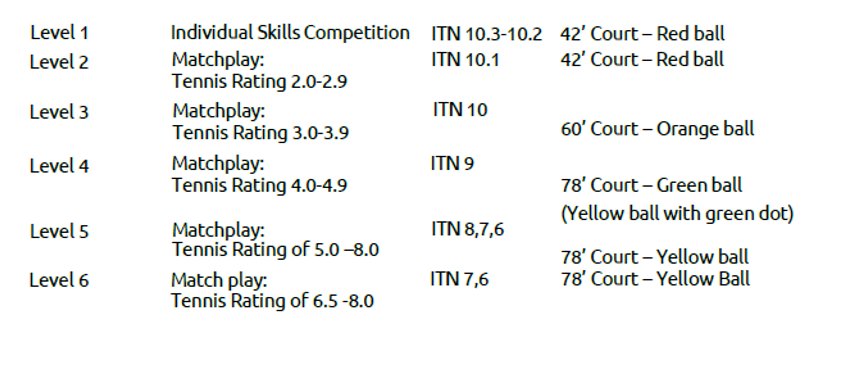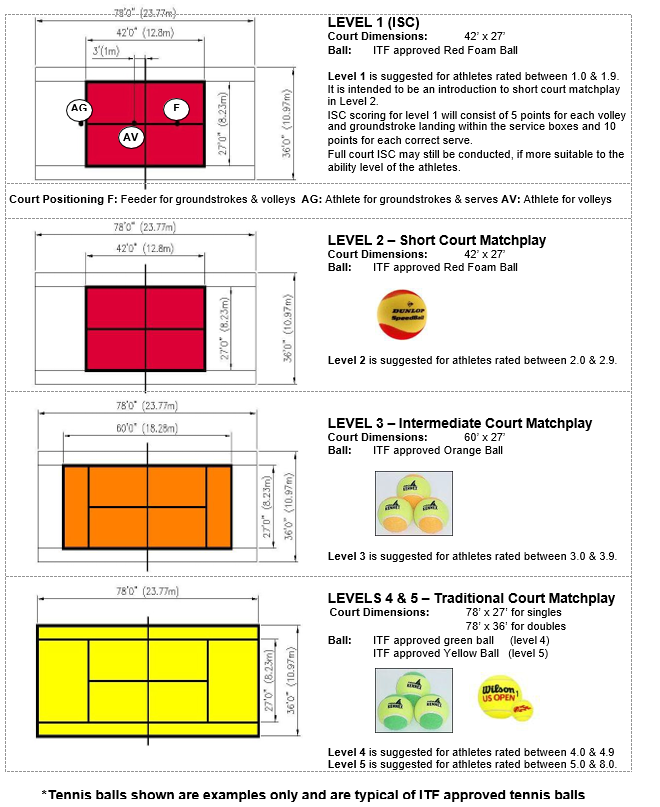Tennis Rules
Valid through 2025
Special Olympics New Hampshire has created this set of rules based on the International Tennis Federation (ITF) rules.
These rules shall be used to govern all Special Olympics New Hampshire Tennis competition through the end of 2025 when we next review these rules.
Events offered
- We offer Tennis competition in the following events
- Individual Skills Competition
- Singles
Registration
- Athletes may only compete in one event, either Individual Skills or Singles
- For athletes registering in Singles, you must also indicate your level of play (see rating sheet)
Divisioning
- Athletes will be divisioned based on their event and level of play.
Equipment
- Athletes should be neat in their dress and wear proper tennis clothing and soft-soled athletic shoes.
- Athletes will use the size tennis ball that corresponds with their event and level.
- Level 1 Individual Skills – Red ball
- Level 2 Singles – Red Ball
- Level 3 Singles – Orange Ball
- Level 4 Singles – Green Ball (Yellow ball with green dot)
- Level 5 Singles – Yellow Ball
- Level 6 Singles – Yellow Ball
- Racket
- The racket shall not exceed 73.7 cm (29.0 inches) in overall length, and 31.7 cm (12.5 inches) in overall width. The hitting surface shall not exceed 39.4 cm (15.5 inches) in overall length, when measured parallel to the longitudinal axis of the handle, and 29.2 cm (11.5 inches) in overall width, when measured perpendicular to the longitudinal axis of the handle.
- Local programs and athletes must supply their own equipment for local training prior to State Competition. At State Competition, appropriate sized tennis balls will be supplied and athletes must supply their own racket.
Competition
- Match Play
- A match will consist of one of the following:
- One Tie Break 6 game set using no-ad scoring with a margin of two games with a 7-point tie-break played at six all.
- In the two tie break 4 game or 6 game sets, there will be a three- minute rest period prior to the deciding 10-point tie-break.
- The No-Ad scoring system will be used for all match play. The No-Ad procedure is simply what the name implies: The first player to win four points wins the game, with the seventh point of a game becoming a game point for each player.
- Single Matches
- The receiver has the choice of advantage court or deuce court, the service on the seventh point, is to be delivered to the nominated court.
- The Service
- The service shall be delivered in the following manner: Immediately before commencing to serve, the server shall stand with both feet at rest behind (i.e. further from the net than) the base-line, and within the imaginary continuations of the center mark and side-line. The server shall then project the ball by hand into the air in any direction, and before it hits the ground, strike it with the racket and the delivery shall be deemed to have been completed at the moment of the impact of the racket and the ball. A player with the use of only one arm may utilize his racket for the projection. The player may use an underhand or overhand service at their discretion.
- The service is a fault if the athlete misses the ball in attempting to strike it. The ball shall not bounce before being struck or it is a fault. The server receives two attempts to serve a good serve.
- A serve hitting the net and landing in the correct service box is called a let and is replayed.
- Continuous Play
- As a principle, play should be continuous, from the time the match starts (when the first service of the match is put in play) until the match finishes.
- Between points, a maximum of 20 seconds is allowed. When the players change ends at the end of a game, a maximum of 90 seconds are allowed. However, after the first game of each set and during a tie-break game, play shall be continuous and the players shall change ends without a rest.
- If a tie-break is necessary, there shall be a set break of a maximum of 120 seconds before the tie-break starts.
- The maximum time starts from the moment that one point finishes until the first service is struck for the next point.
- Score Calling
- The score calling may be either in the conventional terms or simple numbers, i.e., “zero, one, two, three, game.”
- Coaching
- One designated Special Olympics coach may sit on court, (off the playing surface, in a chair located at the net post next to the umpire’s chair) and may coach a player when the players change ends at the end of every odd game and during the three-minute rest period prior to the deciding tie-break, and not during a tie-break game. Changes of ends must be completed within 90 seconds.
- Tie Breakers
- When two or more athletes or teams have the same final point score, the tie shall be broken as follows:
- First: the fewest number of sets lost in all matches
- Second: the most games won in all matches
- Third: the fewest number of games lost in all matches
- Fourth: (other than for teams) head to head results
- When two or more athletes or teams have the same final point score, the tie shall be broken as follows:
- Additional Rules
- A ball landing on a line is considered good.
- A point is called after the ball has touched the ground.
- Touching the ball before the ball touches the ground on a serve awards the point to the server. Only on the serve must the ball bounce before the opponent hits it. If the ball touches any part of the opponents clothing, body or racquet, the point is awarded to the server.
- Athletes should receive a five-minute warm-up on court prior to the start of the match.
- A match will consist of one of the following:
- Individual Skills Competition
- Level 1 ball will be used at Individual Skills Competition (red ball)
- Skills include
- Forehand volley
- The athlete stands approximately one meter from the net with the feeder on the other side of the net, positioned halfway between the service line and the net. Each athlete is given five attempts to hit a ball safely over the net. The feeder underhand tosses each ball to the athlete’s forehand side.
- The athlete scores 5 points for hitting into the service box into either service box.
- Backhand Volley
- Same as forehand volley except feeder sends the balls to athlete’s backhand side.
- Each athlete is given five attempts.
- Forehand Groundstroke
- The athlete stands one meter behind the center (T) of the service line. The feeder is on the other side of the net, positioned half way between the service line and the net, underhand tosses the ball so it bounces once before reaching the athlete’s forehand side. Each athlete is given five attempts.
- The athlete scores five points for hitting into either service box
- Backhand Groundstroke
- Same as forehand groundstroke except the feeder sends the ball to the athlete’s backhand side.
- Each athlete is given five attempts.
- Serve – Deuce Court
- Each athlete is given five attempts to hit a legal serve from the right court to the deuce service box. A ball landing in the correct service box will count 10 points. A zero (0) score is recorded if the athlete commits a foot fault or fails to get the ball in the service box. A foot fault occurs when the athlete steps on or over the service line.
- Serve – Advantage Court
- Same as serve to deuce court but from the left court to the advantage service box.
- Each athlete is given five attempts.
- Alternating Groundstrokes with Movement
- The athlete begins one meter behind the center (T) of the service line. The feeder is on the other side of the net positioned halfway between the service line and the net. It alternates underhand tosses to the athlete’s forehand and backhand sides. Each toss should land at a point which is both halfway between the service line and the net and halfway between the center service line and singles sideline.
- The athlete must be allowed to return to the center mark before feeding the next ball. Each athlete is given ten attempts.
- The athlete scores five points for hitting into either service box.
- Final Score
- A player’s final score is determined by adding together the scores achieved in each of the seven events which comprise the Individual Skills Competition.
- Forehand volley
- Levels
- The following is a guide to levels designed to provide competition opportunities to athletes of all abilities. Level 1 refers to Individual Skills Competition. Levels 2-Level 5 are for Singles competition.

Tennis Rating Sheet
Court Layout & Equipment
The levels below are suggested as a guide for use in competition, to assist the athletes in their transition from ISC to traditional matchplay.
The choice of level offered in a competition will depend on the ability levels of athletes entering. Consideration must also be given to whether the athlete’s training has included these balls and court sizes.

